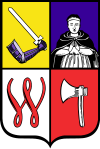 Alternate names: Wągrowiec [Pol], Wongrowitz [Ger], Eichenbrück. 52°48' N, 17°12' E, 28 miles NNE of Poznań (Posen). JOWBR: Jewish Cemetery. 1900 Jewish population: about 400. This town in NW Poland, 50 km from both Poznań and Bydgoszcz is in Greater Poland Voivodeship in the middle of the historical region of Pałuki and the Chodzież lake area (Pojezierze chodzieskie) on the river Wełna and its tributaries Nielba and Struga, as well as on the shores of Durów Lake. The town is the seat of Gmina Wągrowiec, a rural administrative district in Wągrowiec powiat in Greater Poland Voivodeship, [July 2009]
Alternate names: Wągrowiec [Pol], Wongrowitz [Ger], Eichenbrück. 52°48' N, 17°12' E, 28 miles NNE of Poznań (Posen). JOWBR: Jewish Cemetery. 1900 Jewish population: about 400. This town in NW Poland, 50 km from both Poznań and Bydgoszcz is in Greater Poland Voivodeship in the middle of the historical region of Pałuki and the Chodzież lake area (Pojezierze chodzieskie) on the river Wełna and its tributaries Nielba and Struga, as well as on the shores of Durów Lake. The town is the seat of Gmina Wągrowiec, a rural administrative district in Wągrowiec powiat in Greater Poland Voivodeship, [July 2009]
The first documentation of Jews here was in the four Jews living there in 1780. Previously the church banned Jewish settlements in the city. Their number grew to 28 in 1793, 130 in 1808 and 812 in 1847. In 1921, the Jewish population declined only 260 people due to immigration overseas with 206 in 1939. In September 1939, the Germans shot four Jews. Others were deported to Gniezno in the autumn and then to the ghetto in the Lublin and from there to Treblinka. [July 2009]
CEMETERY: Founded early in the 19th century on a hill above Lake Durowskim on the current ul. Kościuszki, the Nazis partially destroyed the cemetery during WWII. Gravestones were used for paving the shores of the lake and Planers Gołaniecki. In 1954, the National Council of the City officially closed the cemetery to create a park and a small fisheries museum. Later, that open-air museum burned down. Vandals destroyed a rose garden [?] put in its place. The PRL ignored the site. Only in 2001 could restoration begin. Thanks to young people in a camp organized by the city and Adendorf Gyula, gravestones and fragments were found. After clearing, the gravestones were set in the cemetery. Local government and businesses participated. On November 29, 2001 the unveiling of the monument (a simple, stylish matzevot inscribed in German, Hebrew and Polish) took place with representatives of local authorities and the Jewish communities in Poland and Wągrow residents. Photos. [November 2009]US Commission No. POCE000429
Alternate German name: Wongrowiec. Wagrowiec is located in Pila region at 52º49' 17º12', 40 km from Poznan. The cemetery is on Koscinszki St. Present population is 25,000-100,000 with no Jews.
- Town: Urzad Miasta w Wagrowcu.
- Regional: mgr. Roman Chwoliszewski, region Konserwator Zabytkow, 64-920 Pila, 1 Tczewska St., tel. 23-88. Panistwowa Sluiba Ochrony Zabytkow Addnar w Pila and Barbara Luczynska.
- Interested: mgr. Marek Fijatkowski, Museum Okiegowe, 64-920 Pila, 1 Chopino St, tel. 271-37.
The synagogue was built in 1807 and destroyed in 1940. The isolated, unlandmarked, Progressive/Reform, suburban hillside by water has no sign, wall, fence, or gate. Reached by turning directly off a public road, access is open to all. The cemetery was 1.16 hectare before 1939. There are no visible gravestones. The municipality owns property is used for recreation. Adjacent property is recreational and agricultural. The size is smaller than in 1939 due to a walkway by the lake. The cemetery was vandalized during WWII with no maintenance, no care. There are no threats.
Henryk Grecki, 70-534 Szcrecin, 3/73 Soltysia St., tel. 377-41 completed survey August 30, 1991 but did not visit.
